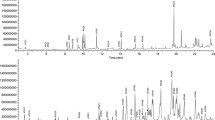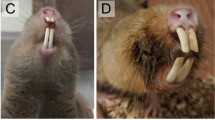Abstract
In mammals, especially rodents, social behaviours, such as parenting, territoriality or mate attraction, are largely based on olfactory communication through chemosignals. These behaviours are mediated by species-specific chemosignals, including small organic molecules and proteins that are secreted in the urine or in various fluids from exocrine glands. Chemosignal detection is mainly ensured by olfactory neurons in two specific sensory organs, the vomeronasal organ (VNO) and the main olfactory epithelium (MOE). This study aimed to characterise the olfactory communication in the fossorial ecotype of the water voles, Arvicola terrestris. We first measured the olfactory investigation of urine and lateral scent gland secretions from conspecifics. Our results showed that water voles can discriminate the sex of conspecifics based on the smell of urine, and that urinary male odour is attractive for female voles. Then, we demonstrated the ability of the VNO and MOE to detect volatile organic compounds (VOCs) found in water vole secretions using live-cell calcium imaging in dissociated cells. Finally, we evaluated the attractiveness of two mixtures of VOCs from urine or lateral scent glands in the field during a cyclical outbreak of vole populations.





Similar content being viewed by others
Data availability
Relevant data are available from the corresponding author.
References
Airoldi J-P (1976) Le terrier de la forme fouisseuse du campagnol terrestre, Arvicola terrestris scherman Shaw (Mammalia, Rodentia). Rev Suisse Zool 41:23–42
Airoldi J-P (1978) Etude par capture et recapture d’une population de campagnols terrestre. Arvicola terrestris scherman shaw. Mammalia, Rodentia. Rev Ecol-Terre Vie 32
Balkenius A, Johansson AJ, Balkenius C (2015) Comparing analysis methods in functional calcium imaging of the insect brain. PLoS ONE 10:e0129614. https://doi.org/10.1371/journal.pone.0129614
Barrios AW, Núñez G, Sánchez-Quinteiro P, Salazar I (2014) Anatomy, histochemistry, and immunohistochemistry of the olfactory subsystems in mice. Front Neuroanat 8:1–10. https://doi.org/10.3389/fnana.2014.00063
Chamero P, Marton TF, Logan DW et al (2007) Identification of protein pheromones that promote aggressive behaviour. Nature 450:899–902. https://doi.org/10.1038/nature05997
DelBarco-Trillo J, LaVenture AB, Johnston RE (2009) Male hamsters discriminate estrous state from vaginal secretions and individuals from flank marks. Behav Processes 82:18–24. https://doi.org/10.1016/j.beproc.2009.03.003
Dey S, Chamero P, Pru JK et al (2015) Cyclic regulation of sensory perception by a female hormone alters behavior. Cell 161:1334–1344. https://doi.org/10.1016/j.cell.2015.04.052
Evsikov VI, Nazarova GG, Potapov MA (1994) Female odor choice, male social rank, and sex ratio in the water vole. Adv Biosci 93:303–307
Ferkin MH, Zucker I (1991) Seasonal control of odour preferences of meadow voles (Microtus pennsylvanicus) by photoperiod and ovarian hormones. J Reprod Fert 92:433–441. https://doi.org/10.1530/jrf.0.0920433
Ferkin MH, Ferkin FH, Richmond M (1994) Sources of scent used by prairie voles, Microtus ochrogaster, to convey sexual identity to conspecifics. Can J Zool 72:2205–2209. https://doi.org/10.1139/z94-295
Fernández-Vargas M, Tang-Martínez Z, Phelps SM (2008) Olfactory responses of neotropical short-tailed singing mice, Scotinomys teguina, to odors of the mid-ventral sebaceous gland: discrimination of conspecifics, gender, and female reproductive condition. J Chem Ecol 34:429–437. https://doi.org/10.1007/s10886-008-9428-0
Frost P, Giegel JL, Weinstein GD, Gomez EC (1973) Biodynamic studies of hamster flank organ growth: hormonal influences. J Invest Dermatol. https://doi.org/10.1111/1523-1747.ep12676217
Hurst JL (1990) Urine marking in populations of wild house mice Mus domesticus rutty. I. Communication between males. Anim Behav 40:209–222. https://doi.org/10.1016/S0003-3472(05)80916-9
Hurst JL, Robertson DHL, Tolladay U, Beynon RJ (1998) Proteins in urine scent marks of male house mice extend the longevity of olfactory signals. Anim Behav 55:1289–1297. https://doi.org/10.1006/anbe.1997.0650
Jemiolo B, Xie TM, Novotny M (1991) Socio-sexual olfactory preference in female mice: attractiveness of synthetic chemosignals. Physio Behav 50:1119–1122. https://doi.org/10.1016/0031-9384(91)90570-E
Jewell S, Witten D (2018) Exact spike train inference via ℓ0 optimization. Ann Appl Stat 12:2457–2482. https://doi.org/10.1214/18-AOAS1162
Johnston RE (1979) Olfactory preferences, scent marking, and proceptivity in female hamsters. Horm Behav 13:21–39. https://doi.org/10.1016/0018-506X(79)90032-1
Johnston RE (2003) Chemical communication in rodents: from pheromones to individual recognition. J Mammal 84:1141–1162
Kaur AW, Ackels T, Kuo TH et al (2014) Murine pheromone proteins constitute a context-dependent combinatorial code governing multiple social behaviors. Cell 157:676–688. https://doi.org/10.1016/j.cell.2014.02.025
Keller M, Baum MJ, Brock O et al (2009) The main and the accessory olfactory systems interact in the control of mate recognition and sexual behavior. Behav Brain Res 200:268–276. https://doi.org/10.1016/j.bbr.2009.01.020
Kimoto H, Haga S, Sato K, Touhara K (2005) Sex-specific peptides from exocrine glands stimulate mouse vomeronasal sensory neurons. Nature 437:898–901. https://doi.org/10.1038/nature04033
Lai SC, Vasilieva NY, Johnston RE (1996) Odors providing sexual information in Djungarian hamsters: evidence for an across-odor code. Horm Behav 30:26–36. https://doi.org/10.1006/hbeh.1996.0005
Lee NS, Goodwin NL, Freitas KE, Beery AK (2019) Affiliation, aggression, and selectivity of peer relationships in meadow and prairie voles. Front Behav Neurosci 13:1–9. https://doi.org/10.3389/fnbeh.2019.00052
Leinders-Zufall T, Brennan P, Widmayer P et al (2004) MHC class I peptides as chemosensory signals in the vomeronasal organ. Science 306:1033–1037. https://doi.org/10.1126/science.1102818
Liberles SD (2014) Mammalian pheromones. Annu Rev Physiol 76:151–175. https://doi.org/10.1146/annurev-physiol-021113-170334
Liu D, Huang KJ, Zhang JX (2011) Individual recognition and odor in rat-like hamsters: behavioral responses and chemical properties. Chem Senses 36:799–810. https://doi.org/10.1093/chemse/bjr055
Lucky AW, McGuire J, Nydorf E et al (1986) Hair follicle response of the golden syrian hamster flank organ to continuous testosterone stimulation using silastic capsules. J Invest Dermatol 86:83–86. https://doi.org/10.1111/1523-1747.ep12283883
Margolis F (1980) A marker protein for the olfactory chemoreceptor neuron. Proteins of the nervous system. Raven Press, New York, pp 59–84
Mombaerts P, Wang F, Dulac C et al (1996) Visualizing an olfactory sensory map. Cell 87:675–686. https://doi.org/10.1016/S0092-8674(00)81387-2
Nagnan-Le Meillour P, Descamps A, Le Danvic C et al (2019) Identification of potential chemosignals in the european water vole Arvicola terrestris. Sci Rep 9:18378. https://doi.org/10.1038/s41598-019-54935-z
Novotny M, Harvey S, Jemiolo B, Alberts J (1985) Synthetic pheromones that promote inter-male aggression in mice. Proc Natl Acad Sci USA 82:2059–2061. https://doi.org/10.1073/pnas.82.7.2059
Nyby J, Kay E, Bean NJ et al (1985) Male mouse (Mus musculus) attraction to airborne urinary odors of conspecifics and to food odors: effects of food deprivation. J Comp Psychol 99:479–490. https://doi.org/10.1037/0735-7036.99.4.479
Pelosi P, Mastrogiacomo R, Iovinella I et al (2014) Structure and biotechnological applications of odorant-binding proteins. Appl Microbiol Biotechnol 98:61–70. https://doi.org/10.1007/s00253-013-5383-y
Poissenot K, Chorfa A, Moussu C et al (2021a) Photoperiod is involved in the regulation of seasonal breeding in male water voles (Arvicola terrestris). J Exp Biol 224:242792. https://doi.org/10.1242/jeb.242792
Poissenot K, Moussu C, Chesneau D et al (2021b) Field study reveals morphological and neuroendocrine correlates of seasonal breeding in female water voles, Arvicola terrestris. Gen Comp Endocrinol 311:113853. https://doi.org/10.1016/j.ygcen.2021.113853
Roberts SA, Simpson DM, Armstrong SD et al (2010) Darcin: a male pheromone that stimulates female memory and sexual attraction to an individual male’s odour. BMC Biol. https://doi.org/10.1186/1741-7007-8-75
Saucy F (1988) Dynamique de population, dispersion et organisation sociale de la forme fouisseuse du campagnol terrestre, (Arvicola terrestris scherman (shaw), Mammalia, Rodentia). PhD thesis, Université de Neuchatel
Shapiro LE, Dewsbury DA (1986) Male dominance, female choice and male copulatory behavior in two species of voles (Microtus ochrogaster and Microtus montanus). Behav Ecol Sociobiol 18:267–274. https://doi.org/10.1007/BF00300003
Somoano A, Ventura J, Miñarro M (2017) Continuous breeding of fossorial water voles in northwestern Spain: potential impact on apple orchards. Folia Zool 66:37–49. https://doi.org/10.25225/fozo.v66.i1.a6.2017
Stoddart DM (1972) The lateral scent organs of Arvicola terrestris (Rodentia: Microtinae). J Zool 166:49–54
Stoddart DM, Aplin RT, Wood MJ (1975) Evidence for social difference in the flank organ secretion of Arvicola terrestris (Rodentia: Microtinae). J Zool 1799:529–540
Tirindelli R (2021) Coding of pheromones by vomeronasal receptors. Cell Tissue Res 383:367–386. https://doi.org/10.1007/s00441-020-03376-6
Tirindelli R, Dibattista M, Pifferi S, Menini A (2009) From pheromones to behavior. Physiol Rev 89:921–956. https://doi.org/10.1152/physrev.00037.2008
Trouillet A-C, Keller M, Weiss J et al (2019) Central role of G protein Gαi2 and Gαi2 + vomeronasal neurons in balancing territorial and infant-directed aggression of male mice. Proc Natl Acad Sci USA 116:5135–5143. https://doi.org/10.1073/pnas.1821492116
Trouillet A, Moussu C, Poissenot K et al (2021) Sensory detection by the vomeronasal organ modulates experience-dependent social behaviors in female mice. Front Cell Neurosci 15:1–13. https://doi.org/10.3389/fncel.2021.638800
Vandenbergh JG (1973) Effect of gonadal hormone on the flank gland of the golden hamster. Horm Res Paediatr 4:28–33. https://doi.org/10.1159/000178287
Varner E, Gries R, Takács S et al (2019) Identification and field testing of volatile components in the sex attractant pheromone blend of female house mice. J Chem Ecol 45:18–27. https://doi.org/10.1007/s10886-018-1032-3
Varner E, Jackson H, Mahal M et al (2020) Brown rats and house mice eavesdrop on each other’s volatile sex pheromone components. Sci Rep 10:17701. https://doi.org/10.1038/s41598-020-74820-4
Winslow JT, Hastings N, Carter CS et al (1993) A role for central vasopressin in pair bonding in monogamous prairie voles. Nature 365:545–548. https://doi.org/10.1038/365545a0
Wyatt TD (2014) Pheromones and animal behavior. Cambridge University Press, Cambridge
Zancanaro C (2014) Vomeronasal organ: a short history of discovery and an account of development and morphology in the mouse. In: Mucignat-Caretta C (ed) Neurobiology of chemical communication, 1st edn. Chapter 9. CRC Press Taylor & Francis Group, US. pp 285–296
Acknowledgements
The authors thank Marie-Claire Blache of the Cellular Imagery Platform (PIC, UMR-PRC), the farmers for the access to their grasslands, and the housing facilities of Campus des Cézeaux (Université Clermont Auvergne), and of Unité RS2GP (INRAE VetAgro Sup).
Funding
This work was supported by the Ministère de l’Agriculture et de l’Alimentation, the DRAAF Auvergne-Rhône-Alpes as well as the Région Auvergne-Rhône-Alpes as a part of the “convention de Massif Central 2015–2020”.
Author information
Authors and Affiliations
Contributions
KP, A-CT, MN, DC, ET, and CM performed experiments; KP and A-CT analysed the data; KP wrote the first draft of the manuscript and designed the figures; PC, VL, A-CT, ET, AC, FS, JD, CLD, PNLM provided equipment, animal facility acces and helped conceiving the study; All authors reviewed the manuscript; MK supervised the study and acquired the funding.
Corresponding author
Ethics declarations
Conflict of interest
The authors declare no competing interests.
Ethical statement
This study was carried out in accordance with European directive 2010/60/UE and was approved by ethical committees for animal experimentation (C2EA-02, project 21994-109 201907510411944 and C2EA-18, project 1857-2018110717044913). Trapping of water voles was allowed in the French department of Puy-de-Dôme by prefectural authorization 19–00100.
Additional information
Handling Editor: Wolfgang Rössler.
Publisher’s Note
Springer Nature remains neutral with regard to jurisdictional claims in published maps and institutional affiliations.
Supplementary Information
Below is the link to the electronic supplementary material.
359_2023_1671_MOESM1_ESM.eps
Supplementary material 1 Hematoxylin-eosin-stained sections of caudal nasal cavity of water voles from anterior (left) to posterior levels (right). *indicates the presence of an additional ethmoturbinate compared to mice and rats (EPS 1317.4 kb)
Rights and permissions
Springer Nature or its licensor (e.g. a society or other partner) holds exclusive rights to this article under a publishing agreement with the author(s) or other rightsholder(s); author self-archiving of the accepted manuscript version of this article is solely governed by the terms of such publishing agreement and applicable law.
About this article
Cite this article
Poissenot, K., Trouillet, AC., Trives, E. et al. Sexual discrimination and attraction through scents in the water vole, Arvicola terrestris. J Comp Physiol A (2023). https://doi.org/10.1007/s00359-023-01671-5
Received:
Revised:
Accepted:
Published:
DOI: https://doi.org/10.1007/s00359-023-01671-5




